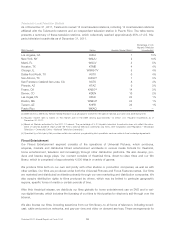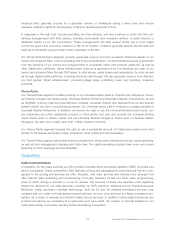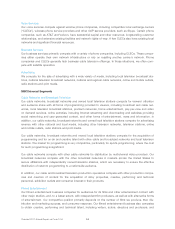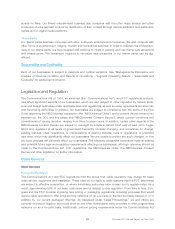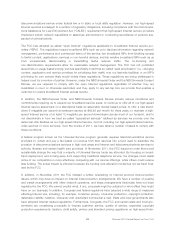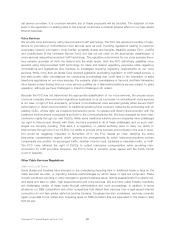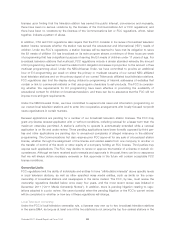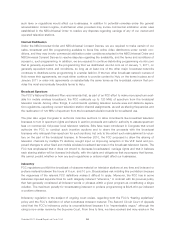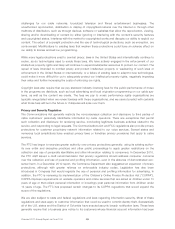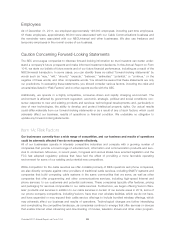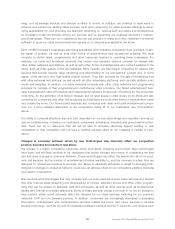Comcast 2011 Annual Report Download - page 22
Download and view the complete annual report
Please find page 22 of the 2011 Comcast annual report below. You can navigate through the pages in the report by either clicking on the pages listed below, or by using the keyword search tool below to find specific information within the annual report.net service providers. It is uncertain whether any of these proposals will be adopted. The adoption of new
laws or the application of existing laws to the Internet could have a material adverse effect on our high-speed
Internet business.
Voice Services
We provide voice services by using interconnected VoIP technology. The FCC has adopted a number of regu-
lations for providers of nontraditional voice services such as ours, including regulations relating to customer
proprietary network information, local number portability duties and benefits, disability access, E911, CALEA
and contributions to the Universal Service Fund, but has not yet ruled on the appropriate classification of
voice services using interconnected VoIP technology. The regulatory environment for our voice services there-
fore remains uncertain at both the federal and the state levels. Until the FCC definitively classifies voice
services using interconnected VoIP technology for state and federal regulatory purposes, state regulatory
commissions and legislatures may continue to investigate imposing regulatory requirements on our voice
services. While more than 20 states have enacted legislation precluding regulation of VoIP-based service, a
few state public utility commissions are conducting proceedings that could lead to the imposition of state
telephone regulations on our voice services. For example, state commissions in Vermont and New Hampshire
have issued orders finding that our voice service qualifies as a telecommunications service subject to state
regulation, although we have challenged or intend to challenge both orders.
Because the FCC has not determined the appropriate classification of our voice services, the precise scope
of phone company interconnection regulations applicable to us as a provider of nontraditional voice services
is not clear. In light of this uncertainty, providers of nontraditional voice services typically either secure CLEC
authorization or obtain interconnection to traditional wireline phone company networks by contracting with an
existing CLEC, whose right, as a telecommunications carrier, to request and obtain interconnection with the
traditional wireline phone companies is set forth in the Communications Act. We have arranged for such inter-
connection rights through our own CLECs. While some traditional wireline phone companies have challenged
our right to interconnect directly with them, we have prevailed in all of these challenges, and no such chal-
lenges are currently pending. That said, if a regulatory or judicial authority were to deny our ability to
interconnect through one of our CLECs, our ability to provide voice services and compete in the area in ques-
tion would be negatively impacted. In November 2011, the FCC issued an order clarifying the entire
intercarrier compensation regime, which governs the arrangements by which telecommunications carriers
compensate one another for exchanged traffic, whether it be for local, intrastate or interstate traffic, or VoIP.
The FCC order affirmed the right of CLECs to collect intercarrier compensation when providing inter-
connection for VoIP providers. However, the FCC’s order is currently under appeal with the Tenth Circuit
Court of Appeals.
Other Cable Services Regulations
State and Local Taxes
Some states and localities have imposed or are considering imposing new or additional taxes or fees on the
cable services we offer, or imposing adverse methodologies by which taxes or fees are computed. These
include combined reporting or other changes to general business taxes, central assessments for property tax,
and taxes and fees on video, high-speed Internet and voice services. We and other cable industry members
are challenging certain of these taxes through administrative and court proceedings. In addition, in some
situations our DBS competitors and other competitors that deliver their services over a high-speed Internet
connection do not face similar state tax and fee burdens. Congress has also considered, and may consider
again, proposals to bar states from imposing taxes on DBS providers that are equivalent to the taxes or fees
that we pay.
Comcast 2011 Annual Report on Form 10-K 20


